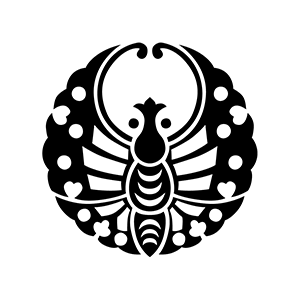Okayama Domain (1/2)Hideie Ukita built the foundation and the Ikeda clan ruled.

Ikeda family crest “Bizen butterfly”
- Article category
- History of the domain
- domain name
- Okayama Domain (1603-1871)
- Affiliation
- Okayama Prefecture
- Related castles, temples and shrines

Okayama Castle
- related castles
The Okayama domain was a large Tozama domain that owned all of Bizen and part of Bicchu. The Ikeda family, including Tadatsugu Ikeda, the second son of Terumasa Ikeda, who fought with the Western army at the Battle of Sekigahara and was later exiled to Hachijojima, built Himeji Castle, and after Hideaki Kobayakawa, built Himeji Castle into its current form. It ruled until the end of the Edo period.
Let's unravel the history of the Okayama clan.
Okayama domain until the Ikeda family ruled
In Okayama, Hideie Ukita, a member of the Five Elders of the Toyotomi family, built Okayama Castle and established a castle town.
Hideie Ukita inherited the territory of his father, Naoie Ukita, who rose to become a feudal lord in the Sengoku period through an uprising, and spent eight years extensively renovating Okayama Castle and establishing the castle town of Okayama.
However, as mentioned above, after the Battle of Sekigahara, Hideie Ukita was banished to Hachijojima and exiled, and Hideaki Kobayakawa, who is famous for defecting from the Western Army to the Eastern Army during the Battle of Sekigahara, entered the area. We will receive 510,000 koku from Bizen and Mimasaka.
Hideaki Kobayakawa left behind a certain amount of achievements, such as renovating Okayama Castle, but he suddenly died just two years after entering the castle.
Since Hideaki Kobayakawa had no legitimate children, the Kobayakawa family ended here.
Reign of the Ikeda family
Terumasa Ikeda's second son, Tadatsugu Ikeda, assumed the position of lord of the Okayama Domain, which had no family to rule it again.
Ikeda Tadatsugu's mother was Tokugawa Ieyasu's second daughter and Tokuhime, so she was Tokugawa Ieyasu's grandson.
However, since he was only five years old when he became the lord of the castle, his half-brother Toshitaka Ikeda moved to Okayama as acting lord, and Tadatsugu Ikeda remained at Himeji Castle, which was ruled by his father.
Here, the Okayama clan was officially established.
In 1613, the daimyō was increased by approximately 100,000 koku to 380,000 koku, making him one of the top daimyo among the Tozama daimyo.
However, Tadatsugu Ikeda died without an heir in 1615, so his younger brother Tadao Ikeda, who ruled Awaji Province, became the second lord of the castle.
Tadao Ikeda renovated Okayama Castle to a formality worthy of a stone high school and developed the castle town.
Furthermore, they worked on new field development and flood control construction, but in 1630, an incident occurred in which a page they had been eyeing was murdered by a feudal retainer, Matagoro Kawai.
Enraged, Tadao Ikeda ordered Matagoro to be captured, but he was hidden by the hatamoto, Ando Shochin, and a battle ensued between the Ikeda family of the Okayama domain and the hatamoto's reputation.
Tadatsugu Ikeda died during this commotion, but there is a theory that he may have been poisoned.
By the way, this conflict between the Ikeda family of the Okayama domain and the hatamoto was finally settled when the page's older brother, who was later killed, took revenge on Matagoro Kawai.
This is still passed down as the ``Duel at the Locksmith's Crossroads,'' and is considered one of Japan's three great revenges, along with the Ako Ronin raid and the Soga Brothers' revenge.
Araki Mataemon, who took part in this revenge with his page's older brother, became famous, and novels, dramas, and movies were made with his name as the title.
Tadao Ikeda had a legitimate son, Mitsunaka Ikeda, but as he was still young, it was judged that he could not rule the Okayama domain, so he was transferred to the Inaba-Tottori domain.
Instead, Mitsumasa Ikeda, who was the lord of the Inaba-Tottori domain, became the lord of the Okayama domain.
Mitsumasa Ikeda was the eldest son of Toshitaka Ikeda, who replaced Tadatsugu Ikeda as the acting lord of the Okayama Domain.
Due to this change of country, Mitsumasa Ikeda's lineage became the lord of the Okayama domain until the Meiji period.
Mitsumasa Ikeda promoted Toshogu Shrine (currently Tamainomiya Toshogu Shrine) as the guardian of Okayama Castle.
Next, he invited the Yomei scholar Kumazawa Banzan to spread Confucianism to the domain. We are opening Hanabatake Kyojo, the first domain school in the Okayama domain.
Later, in 1670, Mitsumasa Ikeda established Shizutani School, known as Japan's oldest school for the common people, and established a political attitude known as the ``Bizen style,'' which emphasized the enhancement of education and frugality. Did.
In addition, they appointed Nagatada Tsuda, the Okayama District Magistrate, to carry out land reclamation projects to develop new rice fields, and to build the Hyakuta River, a drainage channel for the Asahi River.
Due to his wise behavior, Mitsumasa Ikeda is known as one of the three great lords of the early Edo period, along with Mitsukuni Tokugawa, the lord of Mito, and Masayuki Hoshina, lord of Aizu.
In 1672, Mitsumasa handed over the position of lord to his eldest son, Tsunamasa, but continued to hold real power until his death in 1681.
The fourth feudal lord, Tsunamasa Ikeda, is known as the feudal lord who landscaped Okayama Korakuen.
He also appointed Nagatada Tsuda, Tosho Hattori, and others to begin financial reconstruction and put effort into reclamation projects.
Furthermore, we are also conducting flood control work on the Hyakken River and Kurayasu River as a flood countermeasure.
Tsunamasa's policies achieved a certain degree of success, and his finances, which had been on the verge of declining when he became the lord of the domain, were once restored.
In addition, Tsunamasa was known to have many children, with 14 children on record.
However, in reality, there were some illegitimate children who were not officially registered, and one theory is that there were over 70 children.
It is also written as ``dangerous'' in the ``Tsuchikakuhojuki'' and other texts, but there is also a theory that this is because Tsunamasa was not as interested in Confucianism as his father, Mitsumasa, and preferred a culture similar to that of a court noble. there is.
Many of Tsunamasa's children died young, and he was finally able to designate his 12-year-old 17th son Tsugumasa (officially his fourth son) as his successor after he was over 70 years old.
The fifth lord of the domain, Tsugumasa Ikeda, had a gentle and solid personality, and conducted solid politics. For this reason, there is an anecdote that even when uprisings occurred one after another in neighboring domains, the Okayama domain was the only one that remained peaceful without any uprisings.
However, in 1713, Tsugumasa married Murako, the daughter of Date Yoshimura, the fifth lord of the Sendai domain, but they suddenly divorced four years later.
It was unprecedented for a feudal lord to divorce, and because he divorced suddenly without any consultation with the shogunate or the Date family, he was not only subject to scrutiny by the shogunate, but also ended his relationship with the Date family.
The Ikeda family and the Date family finally reconciled in 1784.
Munemasa Ikeda, the 6th lord of the domain who succeeded him, died before his father at the young age of 38, and Harumasa Ikeda, who became the 7th lord of the domain, rebelled against the Kansei reforms implemented by Roju Sadanobu Matsudaira. There is an anecdote that he organized a luxurious procession of daimyo and went down to Edo for the Sankin Kotai.
He was an excellent writer and left many works in the form of paintings and haiku.
Additionally, Shizutani School, which had fallen into disrepair, has been revived.
- related castles

- WriterAYAME(Writer)I am a writer who loves history, focusing on the Edo period. My hobbies are visiting historical sites, temples and shrines, and reading historical novels. If there is a place you are interested in, you can fly anywhere. I'm secretly happy that the number of sword exhibitions has increased recently thanks to the success of Touken Ranbu.



